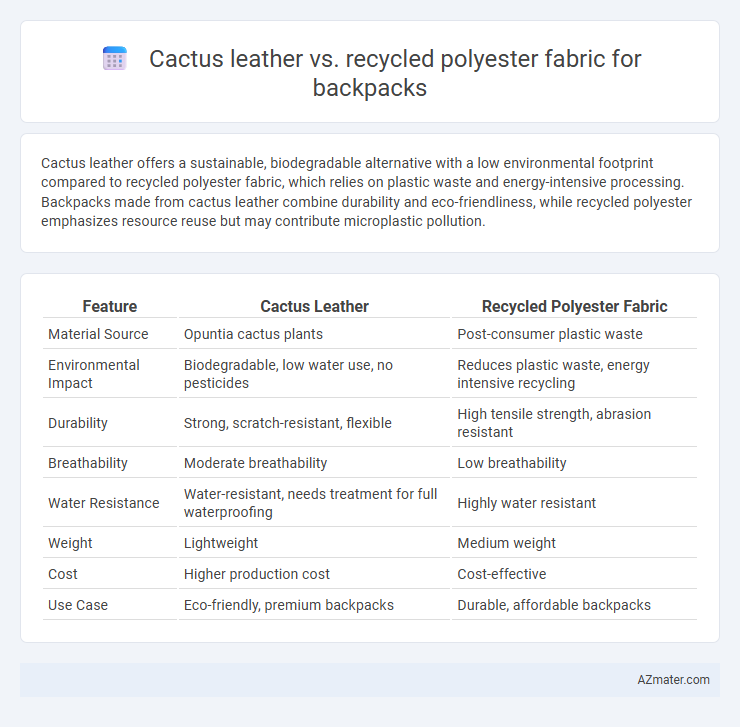Cactus leather offers a sustainable, biodegradable alternative with a low environmental footprint compared to recycled polyester fabric, which relies on plastic waste and energy-intensive processing. Backpacks made from cactus leather combine durability and eco-friendliness, while recycled polyester emphasizes resource reuse but may contribute microplastic pollution.
Table of Comparison
| Feature | Cactus Leather | Recycled Polyester Fabric |
|---|---|---|
| Material Source | Opuntia cactus plants | Post-consumer plastic waste |
| Environmental Impact | Biodegradable, low water use, no pesticides | Reduces plastic waste, energy intensive recycling |
| Durability | Strong, scratch-resistant, flexible | High tensile strength, abrasion resistant |
| Breathability | Moderate breathability | Low breathability |
| Water Resistance | Water-resistant, needs treatment for full waterproofing | Highly water resistant |
| Weight | Lightweight | Medium weight |
| Cost | Higher production cost | Cost-effective |
| Use Case | Eco-friendly, premium backpacks | Durable, affordable backpacks |
Introduction to Sustainable Backpack Materials
Cactus leather offers an innovative, renewable alternative to traditional materials by using mature cactus leaves, significantly reducing water consumption and chemical use in backpack production. Recycled polyester fabric repurposes plastic waste, lowering environmental impact through decreased resource extraction and reduced landfill contribution. Both materials support eco-friendly practices, with cactus leather emphasizing biodegradability and recycled polyester ensuring durability and lightweight performance for sustainable backpacks.
What is Cactus Leather?
Cactus leather is a sustainable material made from mature leaves of the prickly pear cactus, harvested without damaging the plant, allowing for natural regeneration. It is biodegradable, vegan, and eco-friendly, providing a durable and flexible alternative to animal leather. Compared to recycled polyester fabric, cactus leather avoids synthetic microplastic pollution and offers unique textured aesthetics while maintaining high breathability and water resistance for backpack use.
What is Recycled Polyester Fabric?
Recycled polyester fabric is made from post-consumer plastic waste, such as PET bottles, transformed through processes like melting and re-spinning into fibers suitable for textiles. This eco-friendly material reduces landfill waste and lowers reliance on virgin petroleum-based resources while maintaining durability and water resistance ideal for backpacks. Unlike cactus leather, recycled polyester fabric offers a synthetic alternative with strong environmental benefits rooted in circular economy principles.
Environmental Impact: Cactus Leather vs Recycled Polyester
Cactus leather, made from mature nopal cactus leaves, offers a biodegradable and carbon-negative alternative to traditional materials, significantly reducing water usage and agrochemical input compared to recycled polyester fabric, which despite lowering plastic waste reliance, still involves energy-intensive recycling processes and microplastic shedding. The production of cactus leather consumes less water--around 200 liters per kilogram--compared to recycled polyester, which requires more energy and emits greenhouse gases during melting and fiber regeneration. Choosing cactus leather for backpacks supports reduced environmental pollution, enhanced carbon sequestration, and decreased dependency on petrochemical-based resources, fostering a more sustainable manufacturing cycle.
Durability and Performance Comparison
Cactus leather offers exceptional durability with natural resistance to wear and tear, making it highly suited for everyday backpack use, while recycled polyester fabric provides strong tensile strength and water resistance, ensuring long-lasting performance in varied weather conditions. Cactus leather's breathability and flexibility enhance comfort, whereas recycled polyester excels in quick-drying properties and UV resistance, contributing to sustained backpack integrity. Both materials are sustainable alternatives, but cactus leather stands out for its natural robustness, whereas recycled polyester delivers superior performance in moisture management.
Aesthetic and Design Versatility
Cactus leather offers a natural, matte finish with subtle textural variations that enhance the aesthetic appeal of backpacks, making each piece unique and visually engaging. Recycled polyester fabric provides a smooth, consistent surface with vibrant color retention and greater flexibility in prints, patterns, and finishes, allowing for bold and diverse design options. The choice between these materials influences the style narrative, with cactus leather emphasizing eco-luxury and organic sophistication, while recycled polyester focuses on modernity and customizable aesthetics.
Production Process and Resource Consumption
Cactus leather is produced through a sustainable process involving the harvesting of mature cactus leaves without killing the plant, requiring minimal water and no pesticides, significantly reducing environmental impact. Recycled polyester fabric is manufactured by melting down plastic waste, primarily PET bottles, which conserves resources by reusing existing materials but involves energy-intensive processes and potential microplastic shedding. Compared to recycled polyester, cactus leather production consumes less water and energy, making it a more eco-friendly alternative for backpack materials.
Cost Effectiveness and Market Availability
Cactus leather offers a sustainable and premium alternative to traditional materials but generally comes at a higher production cost compared to recycled polyester fabric, which benefits from established mass manufacturing processes and lower raw material expenses. Recycled polyester fabric dominates market availability due to extensive use in the textile industry, making it more accessible and affordable for backpack production. Cost-effectiveness favors recycled polyester for large-scale, budget-conscious consumers, while cactus leather appeals to niche markets prioritizing eco-friendly luxury.
User Experience: Comfort and Practicality
Cactus leather offers a soft, breathable texture that enhances comfort during extended wear, while recycled polyester fabric provides high durability and water resistance, making it practical for various weather conditions. The natural flexibility of cactus leather allows for improved ergonomic support, reducing strain on the shoulders and back. Recycled polyester's lightweight and quick-drying properties ensure backpacks remain functional and convenient for daily use and outdoor activities.
Which Material is Best for Eco-Friendly Backpacks?
Cactus leather offers a sustainable alternative to traditional animal leather, made from mature cactus leaves that require minimal water and no pesticides, making it highly eco-friendly for backpacks. Recycled polyester fabric, derived from post-consumer plastic waste, helps reduce landfill and ocean pollution but involves energy-intensive processing and microplastic shedding. Between the two, cactus leather boasts a lower carbon footprint and biodegradability, making it the best choice for truly eco-friendly backpacks.

Infographic: Cactus leather vs Recycled polyester fabric for Backpack
 azmater.com
azmater.com